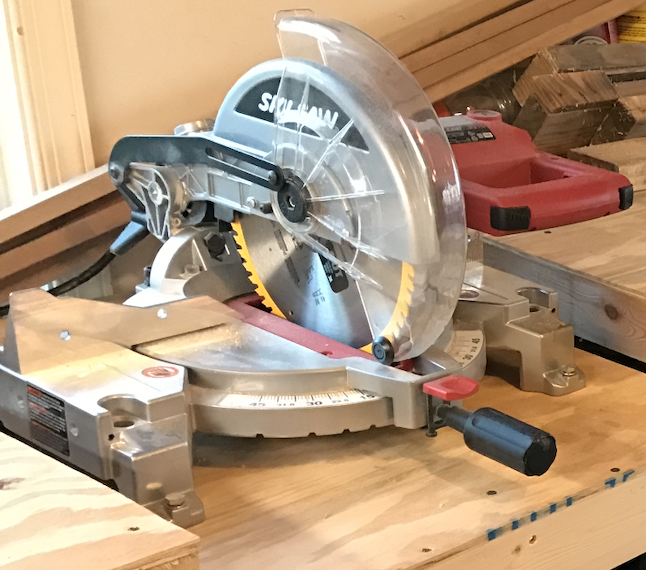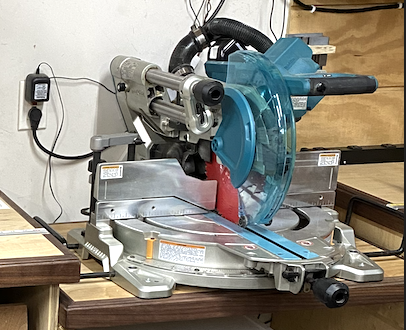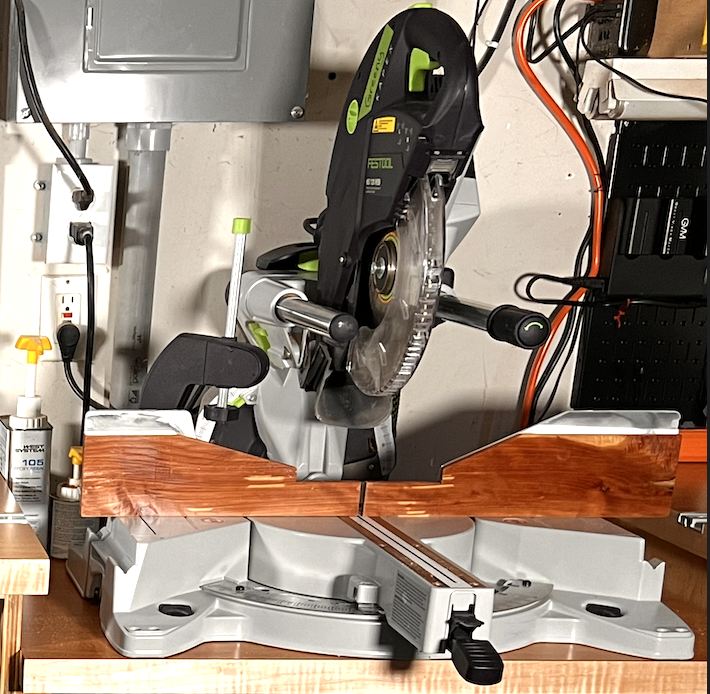Miter Saws - Everything You Need to Know!
For beginner and intermediate woodworkers, investing in a miter saw can significantly enhance your woodworking projects. However, with various types and features available in the market, choosing the right one can be overwhelming. This guide aims to simplify the process by highlighting the most important considerations when buying or upgrading a miter saw.
Basic Terminology
The first step is understanding what types of miter saws are out there, and some of the common miter saw terminology you’ll need to know:
Standard Miter Saw: Ideal for basic angle cuts, this saw pivots left and right to create miter cuts. You will also hear people refer to this as a chop saw, which refers to the fact that it basically just goes up and down.
Compound Miter Saw: In addition to the standard features, the bade of the saw itself tilts in both directions for bevel cuts.
Sliding Compound Miter Saw: In addition to everything you get on a compound miter saw, these saws come with a sliding arm that extends for wider cuts, which is perfect for larger projects.
Other Considerations
Now that you have a basic understanding of the different types of saws, next you can begin to consider blade size and the power source:
Blade Size: The most common sizes you will see are 7 1/4”, 10”, and 12”. This number refers to the diameter of the blade, and as such, a bigger blade size means greater cutting capacity in all dimensions. Consider the types of projects you'll undertake to determine the appropriate blade size.
Power:
Corded Miter Saws: Corded miter saws are powered by electricity from an outlet. They typically offer consistent and uninterrupted power, making them suitable for prolonged use without needing to recharge or replace batteries. Corded models are often preferred for heavy-duty applications and continuous use in a workshop setting.
Battery-Powered (Cordless) Miter Saws: Battery-powered miter saws operate on rechargeable lithium-ion batteries, offering portability and freedom from cords. These saws are convenient for jobsites or locations where access to power outlets may be limited. While cordless miter saws provide mobility, they may have slightly less power compared to their corded counterparts and may require additional battery purchases for extended use.
By considering the power source that best suits your woodworking needs, whether it's the consistent power of a corded miter saw or the portability of a battery-powered model, you can choose the right option for your projects.
I would say that the above categories are your most important and most basic considerations that will guide your decision making. However, with all the saws out there, there are a number of other factors and options that can play into your decision making:
Accuracy and Precision:
Laser Guide: Some miter saws come with a built-in laser guide, which helps improve accuracy by indicating the cutting line.
Positive Stops for the angle or the bevel: Look for miter saws with positive stops (also referred to as detents) for common angles like 45 and 90 degrees, facilitating quick and accurate adjustments.
Dust Collection System:
Miter saws are notoriously some of the messiest machines in your shop.
A miter saw with an effective dust collection system keeps your workspace clean and reduces health hazards associated with wood dust.
Consider models with dust bags or ports for connecting to a vacuum system for efficient debris removal.
Portability and Storage:
Weight and Size: If you need to transport your miter saw frequently, opt for a lightweight and compact model.
Folding or Sliding Stands: Some miter saws come with integrated stands that fold or slide for easy storage when not in use.
Budget and Value:
Determine your budget and prioritize features based on your woodworking needs.
Consider the long-term value of the miter saw, including durability, warranty, and additional features that enhance productivity.
My Miter Saws
Now that we’ve discussed the general features and details out there, let me tall you about my miter saw experience:
My First Miter saw - 7 1/4” Skil Saw
I started out woodworking with a very small, basic Skil 7 1/4” miter saw. At the time, I mostly bought it because it was cheap - somewhere around $120. Similar models currently run between $150-170. I was using it to cut material for outdoor builds, mostly 2 x 4 type material.
Pros:
Cheap, and compact.
Fit my space at the time.
Fine for small, basic woodworking projects, and some outdoor work.
Cons:
Cheap, and compact. It felt cheap in every way. The mechanics were extremely clunky.
There were significant issues with deflection, and it was not really suitable for any kind of highly accurate work.
The small size limited workpiece size.
Loud, and no dust collection to speak of.
The battery powered Makita XSL06PT
As I’ve discussed in previous videos, I was having big time electrical issues in my garage - the Skil saw would trip the breaker constantly, even sometimes with cutting pressure treated 2 x 4. So I wanted a miter saw that would operate off the grid. Enter the battery powered Makita. This is a 10” dual bevel sliding compound miter saw. At the time, this tool alone was selling for about $600, with batteries adding another $150-200 on top of that. Currently, the saw with a charger and 2 batteries (which it needs 2 batteries to run) sells for around $1050. A corded model runs around $750. However, I bought mine used off of Facebook Marketplace and bought some off brand batteries and a 4 port charger. Buying used and knock off batteries, I was all in about $450. I also upgraded to Makita cordless 18v hand held tools at the time.
Pros:
Battery powered, so no need to run electrical in a garage with one 15A circuit.
Very accurate: this has varied amongst users, with many reviews complaining about this saw’s ability to hold its accuracy. However, mine only needed to be dialed in after I bought it, and never went out of square after (even with taking it outing my yard to work on a chicken coop).
Pretty good dust collection for a miter saw.
Increased size, capacity, and options really expanded my capabilities.
Included laser is very accurate.
Cons:
You really want 4 batteries, as I would run out of battery power in the middle of cuts and need to keep working. This increases buy in cost.
Power and cutting capability suffered as the battery drained.
Very heavy, so if you’re looking for an on-site saw, this is not the one.
The hold down is very clunky, and takes a lot of work to set in place. If you’re doing a lot of cuts and need it, this can be time consuming.
The Festool Kapex KS 120 REB
This is my most recent upgrade. For me, this is it. I use the miter saw not just for rough work and breakdown, but for highly accurate and repeatable work. It gets a lot of flak, mostly because of price, but depending on what you are building and how you use it, this is a dream to use.
Pros:
Highly accurate.
Best dust collection by far when it comes to miter saws.
Very easy to use/intuitive controls. if you have used a Festool product before, you know what I mean.
Accurate laser.
The included hold down clamp is quick and easy, and makes me actually want to use it, which increases safety.
Cons:
Really, price is it. It’s expensive. Spending $1600 on a miter saw can certainly seem insane (especially given the cheapest miter saws around clock in at about 1/10 the cost).
Previous models did have some issues with motor burn out, however this was addressed by Festool awhile ago and is no longer a reported issue.
Festool is currently selling a small battery powered version for just under $1000 - this is really geared toward job site work. I have not tested this out.
So What Should You Buy?
So at the end of the day, what should you buy? I would recommend you go through all of the above attributes as questions. For example:
Am I going to use this stationary in a workshop, onsite, or outdoors? Do I need it to be portable?
Do I need corded or battery powered?
What kind and size of material will I be working with?
Do I need to cut compound angles (working with crown moulding) or do I just need some basic chop and miter functions?
Is this primarily going to be used for breakdown of material, or do I want a highly accurate saw?
How important is dust collection?
What is my budget?
If you’re going to be working outdoors, need a small portable saw that doesn’t need great dust collection or compound angles, then a 7 1/4” saw can be had for less than $200.
If you are going to be stationary in a workshop, and want something that is highly accurate, repeatable, can do compound angles, and has great dust collection, then save up.
If budget is a significant concern, but you do want more saw, consider shopping around on the secondhand market. I have purchased a number of my tools, including my previous Makita miter saw, on sites like Facebook Marketplace or CraigsList. If you are patient, and wait for a good deal, there are great deals to be had.
Choosing the right miter saw is crucial for beginner and intermediate woodworkers looking to enhance their woodworking projects. By considering factors such as types, blade size, accuracy, dust collection, portability, and budget, you can make an informed decision when purchasing or upgrading your miter saw. If you have any questions, or have topic ideas for a future blog post, send them to garagedwellersww@gmail.com - we’re happy to help you out! And if you’re thinking about a miter station, make sure you check out this video so you can avoid some of pitfalls most traditional miter stations have!






